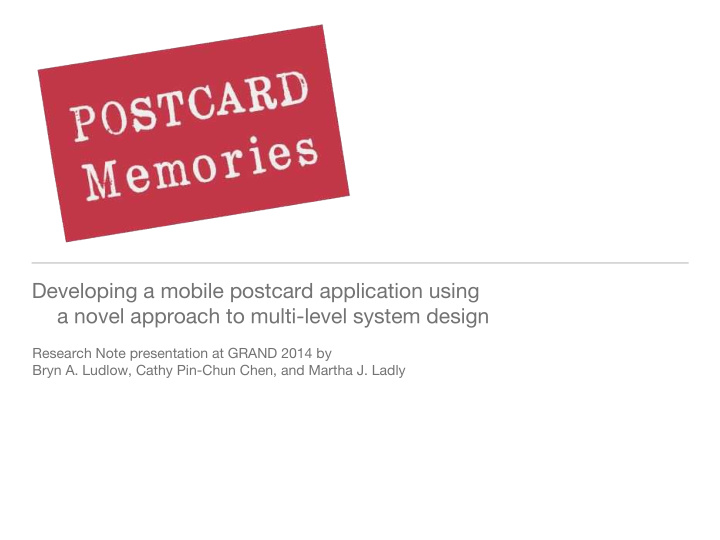



Developing a mobile postcard application using a novel approach to multi-level system design Research Note presentation at GRAND 2014 by Bryn A. Ludlow, Cathy Pin-Chun Chen, and Martha J. Ladly
Research objectives We seek to gain a deeper understanding of narrative storytelling in general, and collaborative digital/physical artifact creation and collection alongside narrative arrangement in particular on a tablet computer, with a specific population of caregivers, and associated geriatric outpatients at Toronto Rehabilitation Institute who have mild to moderate dementia and memory loss of the Alzheimer's type.
Participants Elders with a diagnosis of • "Early Stage Dementia" (ESD); or mild to moderate dementia of the Alzheimer's type, and their: Family members • Friends, and/or caregivers • Image source: http://www.corbisimages.com/stock-photo/rights-managed/42-19897318/affectionate-m iddleaged-and-elderly-women?popup=1
A tablet application with digital and physical outputs 1. Digital Postcard Memories gallery and book; 2. Physical postcards, which can be mailed through Canada Post (using their API which is embedded in the application) and/or can be printed from within the application; 3. A Postcard Memories book, which will allow collected postcards to be arranged and rearranged by the elder and their family members or caregivers into a pleasing narrative format.
Research goals Sharing, re-telling, and • preserving memories Use of speech and facial • recognition software to identify changes associated with dementia Study of engaged and • sustained social interactions with an original touchscreen tablet computer application Image source: http://www.corbisimages.com/stock-photo/royalty-free/42-33758540/young-woman-expl aining-a-tablet-pc-to?popup=1
Research Design • Create a concept map of the research design and methodology to reduce # of slides here.
Flowchart development • We created a flowchart to visualize the application workflow with the software application, "Inspiration" (v. 9)
http://www.inspiration.co m
Inspiration v.9 [8] is a rapid concept mapping program that allows users to: • Create text on a single mouse click; • Rearrange the text on the page; • Change the shape and colour of the text bubbles according to hierarchy and meaning; • Add directional arrows to link relational text bubbles; • Change the line thickness and stroke of the arrows and textboxes.
Flowchart development • The flowcharting process elicited three stages involved in postcard creation: initiation; response; accept, review, and organize.
Benefits of using Inspiration for research design/ design research projects: • A diverse team of programmers, interface designers, architects, and social scientists can ask questions at the development stage, and make quick decisions, changes, and suggestions; • Flowchart be saved in different formats, such as a PDF, which the entire team can work with. • Significantly, creating the flowchart at the same time as writing the research ethics protocol was advantageous, as it reassured the team that our study research design matches the application design, and vice-versa.
Future directions of our research
Acknowledgements We would like to thank Dr. Ronald Baecker for his original inspiration for this project; Dr. Frank Rudzicz (Toronto Rehabilitation Institute, University Health Network); and research assistants at the Mobile Experience Lab for their contributions: Ruzette Pangan Tanyag, Pavika Chintraruck, Pei Zhou, Jessica Peter, and Maziar Ghaderi. Project Website: http://research.ocadu.ca/mobilelab/project/elders-memory
References 1 Novak, M., & Campbell, L. (2010). Aging & society: A Canadian perspective. (6th ed.). Scarborough, ON, Canada: Nelson Education. 2 Harvey, R. J., Skelton-Robinson, M., & Rossor, M. N. (2003). The prevalence and causes of dementia in people under the age of 65 years. Journal of Neurology, Neurosurgery & Psychiatry, 74(9), 1206-1209. 3 Lim, F.S., Wallace, T., Luszcz, M.A., Reynolds, K.J. (2012). Usability of tablet computers by people with early-stage dementia. Gerontology. DOI: 10.1159/000343986. 4 Van Someren, M. W., Barnard, Y. F., & Sandberg, J. A. (1994). The think aloud method: A practical guide to modeling cognitive processes. London: Academic Press. 5 Zimmerman, E. (2008). Play as research: The iterative design process. In M. Ladly & P. Beesley (Eds.), Mobile Nation: Creating methodologies for mobile platforms. Waterloo, ON Canada: Riverside Architectural Press. 6 Newell, A. F., Gregor, P., Morgan, M., Pullin, G., & Macaulay, C. (2011). User-sensitive inclusive design. Universal Access in the Information Society, 10(3), 235-243. 7 Zajicek, M. (2005). Older adults: Key factors in design. In A. Pirhonen, P. Saariluoma, H. Isomäki & C. Roast (Eds.), Future interaction design (pp. 151-176). London, UK: Springer. DOI: 10.1007/1-84628-089-3_9. 8 Helfgott, D., & Westhaver, M. (1982). Inspiration (Version 9) [Software]. Available from http://www.inspiration.com/ 9 Charmaz, K. (2003). Grounded Theory. In S.N. Hesse-Biber & P. Leavy (Eds.), Approaches to qualitative research: A reader on theory and practice. New York, NY: Oxford University Press. Pp. 496-521. 10 Kontos, P. C. (2003). “The painterly hand”: Embodied consciousness and Alzheimer's disease. Journal of Aging Studies, 17(2), 151-170.
Recommend
More recommend